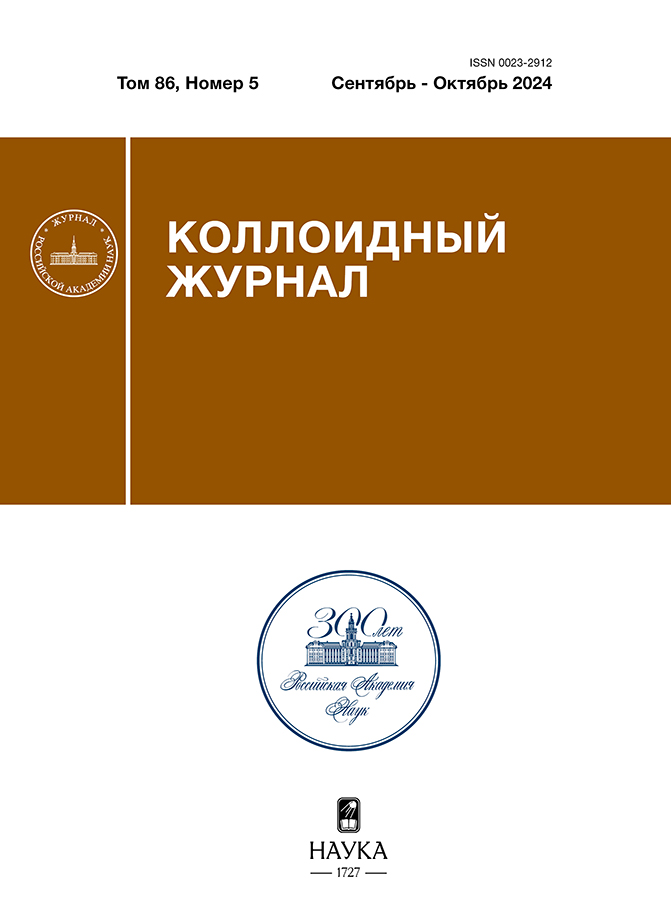Electrostatic Interaction of Dielectric Particles in an Electrolytic Solution
- Авторлар: Grashchenkov S.I.1
-
Мекемелер:
- Псковский государственный университет
- Шығарылым: Том 86, № 5 (2024)
- Беттер: 561-570
- Бөлім: Articles
- ##submission.dateSubmitted##: 27.02.2025
- ##submission.datePublished##: 30.11.2024
- URL: https://ter-arkhiv.ru/0023-2912/article/view/671940
- DOI: https://doi.org/10.31857/S0023291224050045
- EDN: https://elibrary.ru/AAWFWX
- ID: 671940
Дәйексөз келтіру
Аннотация
On the basis of the Poisson-Boltzmann equation the electrostatic interaction between two charged dielectric spherical particles in a symmetric electrolyte solution is considered. The interaction forces between particles of the same radius under the condition of uniform charge distribution on their surfaces in the absence of an external field have been calculated by the finite element method. The dependence of the electrostatic repulsion forces between the particles on the magnitude of the particle charges and the dielectric permittivities of the particle materials and the surrounding medium has been analyzed.
Толық мәтін
Авторлар туралы
S. Grashchenkov
Псковский государственный университет
Хат алмасуға жауапты Автор.
Email: grasi@mail.ru
Ресей, Псков
Әдебиет тізімі
- Israelachvili J. N. Intermolecular and surface forces. San Diego: Academic press, 2011
- Ledbetter J.E., Croxton T.L., McQuarrie D.A. The interaction of two charged spheres in the Poisson–Boltzmann equation // Can. J. Chem. 1981. V. 59. № 13. P. 1860–1864. https://doi.org/10.1139/v81-277
- Gouy M. Sur la constitution de la charge électrique à la surface d’un électrolyte // J. Phys. Theor. Appl. 1910. V. 9. №. 1. P. 457–468. https://hal.science/jpa-00241565/document (accessed on March 06, 2024)
- Huckel E., Debye P. Zur theorie der elektrolyte.I. Gefrierpunktserniedrigung und verwandte erscheinungen // Phys. Z. 1923. V. 24. S. 185–206.
- Lamm G. The Poisson–Boltzmann equation // Reviews in computational chemistry. 2003. V. 19. P. 147–365. https://doi.org/10.1002/0471466638.ch4
- Derjaguin B., Landau L. Theory of the stability of strongly charged lyophobic sols and of the adhesion of strongly charged particles in solutions of electrolytes // Progress in Surface Science. 1993. V. 43. P. 30−59. https://doi.org/10.1016/0079-6816(93)90013-L
- Ether D. S. et al. Double-layer force suppression between charged microspheres // Physical Review E. 2018. V. 97. №. 2 P. 022611. https://doi.org/10.1103/PhysRevE.97.022611
- Schnitzer O., Morozov M. A generalized Derjaguin approximation for electrical-double-layer interactions at arbitrary separations // The Journal of Chemical Physics. 2015. V. 142. №. 24. P. 244102. http://dx.doi.org/10.1063/1.4922546
- Derjaguin B. On the repulsive forces between charged colloid particles and on the theory of slow coagulation and stability of lyophobe sols // Transactions of the Faraday Society. 1940. V. 35. P. 203–215. https://doi.org/10.1016/0079-6816(93)90011-J
- Derbenev I. N. et al. Electrostatic interactions between charged dielectric particles in an electrolyte solution // The Journal of chemical physics. 2016. V. 145. №. 8. P. 084103. http://dx.doi.org/10.1063/1.4961091
- Filippov A. V., Starov V. Interaction of nanoparticles in electrolyte solutions // The Journal of Physical Chemistry B. 2023. V. 127. № 29. P. 6562–6572. https://doi.org/10.1021/acs.jpcb.3c01220
- Гращенков С.И. О силе электростатического взаимодействия двух сфероидальных макрочастиц в модели Пуассона-Больцмана // Журнал технической физики. 2022. Т. 92. № 12. С. 1770–1775. http://dx.doi.org/10.21883/JTF.2022.12.53742.145-22
- Ledbetter J.E., Croxton T.L., McQuarrie D.A. The interaction of two charged spheres in the Poisson–Boltzmann equation // Canadian Journal of Chemistry. 1981. V. 59. №. 13. P. 1860–1864. https://doi.org/10.1139/v81-277
- Carnie S. L., Chan D. Y. C., Stankovich J. Computation of forces between spherical colloidal particles: nonlinear Poisson-Boltzmann theory // Journal of colloid and interface science. 1994. V. 165. № 1. P. 116–128. https://doi.org/10.1006/jcis.1994.1212
- Lima E.R.A., Tavares F.W., Biscaia Jr.E.C. Finite volume solution of the modified Poisson–Boltzmann equation for two colloidal particles // Physical Chemistry Chemical Physics. 2007. V. 9. № 24. P. 3174–3180. https://doi.org/10.1039/b701170a
- Brenner S.L., Roberts R.E. Variational solution of the Poisson-Boltzmann Equation for a spherical colloidal particle // The Journal of Physical Chemistry. 1973. V. 77. № 20. P. 23672370. https://doi.org/10.1021/j100639a001
- Chan D.Y.C., BKC C. Electrical double-layer interaction between spherical colloidal particles: An exact solution Journal of Colloid and Interface Science. 1983. V. 92. № 1. P 281283. https://doi.org/10.1016/0021-9797(83)90143-1
- Dyshlovenko P. Adaptive mesh enrichment for the Poisson–Boltzmann equation // Journal of Computational Physics. 2001. V. 172. № 1. P. 198–208. https://doi.org/10.1006/jcph.2001.6820
- Qiao Z., Li Z., Tang T. A finite difference scheme for solving the nonlinear Poisson-Boltzmann equation modeling charged spheres // Journal of Computational Mathematics. 2006. № 3. P. 252–264.
- Merrill J.W., Sainis S.K., Dufresne E.R. Many-body electrost atic forces between colloidal particles at vanishing ionic strength // Physical review letters. 2009. V. 103. № 13. P. 138301. https://doi.org/10.1103/PhysRevLett.103.138301
- Russ C. et al. Three-body forces between charged colloidal particles // Physical Review E. 2002. V. 66. № 1. P. 011402 https://doi.org/10.1103/PhysRevLett.103.138301
- Warszyński P., Adamczyk Z. Calculations of double-layer electrostatic interactions for the sphere/plane geometry // Journal of colloid and interface science. 1997. V. 187. № 2. P. 283–295. https://doi.org/10.1006/jcis.1996.4671
- Lu B. Finite element modeling of biomolecular systems in ionic solution // Image-Based Geometric Modeling and Mesh Generation. Dordrecht: Springer Netherlands. 2013. P. 271–301. https://doi.org/10.1007/978-94-007-4255-0_14
- Фортов В.Е., Храпак А.Г., Храпак С.А., Молотков В.И., Петров О.Ф. Пылевая плазма. // Успехи физических наук. 2004, V. 174. № 5. P. 495–544. https://doi.org/10.3367/UFNr.0174.200405b.0495
- Gangl P. et al. Fully and semi-automated shape differentiation in NGSolve // Structural and multidisciplinary optimization. 2021. V. 63. №. 3. P. 1579–1607. https://doi.org/10.1007/s00158-020-02742-w
- Carnie S.L., Chan D.Y.C. Interaction free energy between identical spherical colloidal particles: The linearized Poisson-Boltzmann theory // Journal of colloid and interface science. 1993. V. 155. №. 2. P. 297–312. https://doi.org/10.1006/jcis.1993.1039
- Bell G.M., Levine S., McCartney L.N. Approximate methods of determining the double-layer free energy of interaction between two charged colloidal spheres // Journal of Colloid and Interface Science. 1970. V. 33. №. 3. P. 335–359. https://doi.org/10.1016/0021-9797(70)90228-6
- Sainis S.K., Merrill J.W., Dufresne E.R. Electrostatic interactions of colloidal particles at vanishing ionic strength // Langmuir. 2008. V. 24. № 23. P. 13334–13337.
- Choi K.H. et al. Direct measurement of electrostatic interactions between poly (methyl methacrylate) microspheres with optical laser tweezers // Soft matter. 2019. V. 15. № 40. P. 8051–8058. https://doi.org/10.1039/c9sm01374a
Қосымша файлдар

















